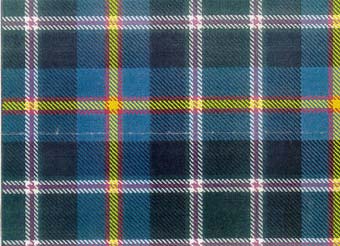Photo of Colorado District tartan © Cal Clark/Thunder Mountain Pipe Band (all rights reserved; used by permission).
Official State Tartan of Colorado
The Colorado District Tartan was officially recognized by Colorado's General Assembly in 1997. All State Tartans
The Colorado tartan is registered with the International Association of Tartan Studies. The following is condensed from Colorado House Resolution 97-1016:
"Coloradans of Scottish, Irish, and other Celtic descents have made significant contributions to the development and cultural richness of Colorado ... the district tartan ... may be worn by any resident or friend of Colorado, whether or not of Celtic heritage ...
July 1 is designated as Tartan Day and the people of Colorado should have an official tartan to wear on that day ...
The official state tartan is comprised of a pattern and colors that are symbolic of Colorado's splendor and history ... The crispness of the color blue captures the beauty of the clear Colorado skies and the coolness of forest green renders images of pine and spruce that grace the mountains with dignity;
The contrasting colors of lavender and white are reflective of the granite mountain peaks and the snow that crowns them in the winter months, inspiring the song America the Beautiful and its references to purple mountain majesties, and are found in the state flower, the white and lavender columbine;
The brilliance of the color gold signifies the vast wealth of mineral resources to which the mining industry was attracted and on which the state's early economy was built; ...The essence of the color red distinguishes the C on the state flag and also signifies the red sandstone soil which gave the area its name Colorado, meaning red in Spanish."
What is a Tartan?
Tartan refers to fabric woven into a unique pattern of multicolored stripes that represents a clan (family) or region in Scotland. In old Scotland, the tartan was used for clothing and as a banner or flag. Because a family or community worked the cloth together, their clothing was made of the same pattern, and so a person could be recognized by the tartan plaid that he wore.
Tartans can also be designed as a symbol commemorating a special event or person. A tartan pattern is traditionally called a "sett." When woven, the sett is mirrored in all directions and defined by a particular thread count.

